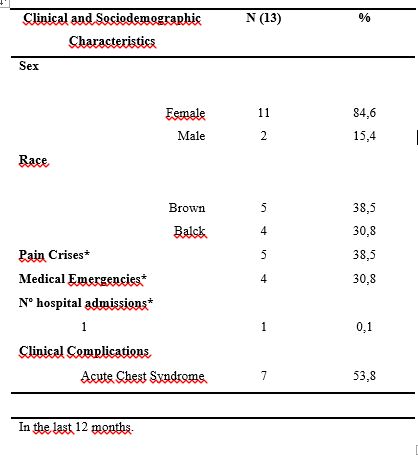
Contributions
Abstract: PB1538
Type: Publication Only
Session title: Enzymopathies, membranopathies and other anemias
Background
Hemoglobin C disease is a type of hemolytic anemia, like sickle cell disease, caused by a structural change on the beta globin gene, which provokes a tendency to hemoglobin cristalization.The disease manifests itself when the two genes in beta globin are altered (HbCC). It usually develops with mild to moderate hemolytic anemia, splenomegaly (most frequent symptom), target cells, HbC crystallization, reticulocytosis and low mean corpuscular volume (CMV).HbC has an affinity slightly reduced by oxygen and tends to crystallize in its oxygenated form, there are more dehydrated, dense, viscous and less deformable erythrocytes, which, however, does not lead to vaso-occlusive crises as occurs in the presence of HbS.There are few reports in the literature about its prevalence in the population and its clinical behavior.
Aims
Describe the clinical manifestations and complications in people with hemoglobin C disease assited in a sickle cell disease reference center in Feira de Santana (BA), Brazil and promote a critical reflection of the multidisciplinary team.
Methods
Descriptive observational study of a case series with 13 children with hemoglobin C disease diagnosed by electrophoresis. Interviews were conducted alongside medical record review to analyse the participants social and clinical variables, as well as laboratorial behavior through hemoglobin levels (Hb).
Results
The studied population consisted of children aged 2-18 years, with the majority of people being in the age group 5-7 years (46.2%).11 particpants were female with an average of 6.6±2.1 years old and 9 identified themselves as black or brown. Regarding the use of medications, 12 people reported use of folic acid, 3 used profilatic penicilin, 4 used painkillers because of painful episodes and 3 reported use of other medications. Concerning clinical manifestations, 1 person had splenomegaly; 5 reported mild to moderate painful episodes in the last 12 months; 7 reported acute chest syndrome (ATS) as complication; no one had any target-organ damage or had gone through blood transfusion in the last 12 months. The hemoglobin levels varied between 8.6-12.6g/dL with an average of 11.3±0.9 g/dL, 4 patients didn’t have anemia, 3 had mild anemia and 3 others had moderate anemia.
Conclusion
This study showed that people with hemoglobin C disease had mild clinical manifestations. Studies are needed to better understand it’s pathophysiology as well as coohort studies to evaluate the clinical evolution of the disease and it’s clinical manisfestions.That way, people with hemoglobina C disease will be able to receive a better defined and beneficial treatment, one that isn’t based only on what is known and established for sickle cell anemia.
Keyword(s): Hemoglobin variants
Abstract: PB1538
Type: Publication Only
Session title: Enzymopathies, membranopathies and other anemias
Background
Hemoglobin C disease is a type of hemolytic anemia, like sickle cell disease, caused by a structural change on the beta globin gene, which provokes a tendency to hemoglobin cristalization.The disease manifests itself when the two genes in beta globin are altered (HbCC). It usually develops with mild to moderate hemolytic anemia, splenomegaly (most frequent symptom), target cells, HbC crystallization, reticulocytosis and low mean corpuscular volume (CMV).HbC has an affinity slightly reduced by oxygen and tends to crystallize in its oxygenated form, there are more dehydrated, dense, viscous and less deformable erythrocytes, which, however, does not lead to vaso-occlusive crises as occurs in the presence of HbS.There are few reports in the literature about its prevalence in the population and its clinical behavior.
Aims
Describe the clinical manifestations and complications in people with hemoglobin C disease assited in a sickle cell disease reference center in Feira de Santana (BA), Brazil and promote a critical reflection of the multidisciplinary team.
Methods
Descriptive observational study of a case series with 13 children with hemoglobin C disease diagnosed by electrophoresis. Interviews were conducted alongside medical record review to analyse the participants social and clinical variables, as well as laboratorial behavior through hemoglobin levels (Hb).
Results
The studied population consisted of children aged 2-18 years, with the majority of people being in the age group 5-7 years (46.2%).11 particpants were female with an average of 6.6±2.1 years old and 9 identified themselves as black or brown. Regarding the use of medications, 12 people reported use of folic acid, 3 used profilatic penicilin, 4 used painkillers because of painful episodes and 3 reported use of other medications. Concerning clinical manifestations, 1 person had splenomegaly; 5 reported mild to moderate painful episodes in the last 12 months; 7 reported acute chest syndrome (ATS) as complication; no one had any target-organ damage or had gone through blood transfusion in the last 12 months. The hemoglobin levels varied between 8.6-12.6g/dL with an average of 11.3±0.9 g/dL, 4 patients didn’t have anemia, 3 had mild anemia and 3 others had moderate anemia.
Conclusion
This study showed that people with hemoglobin C disease had mild clinical manifestations. Studies are needed to better understand it’s pathophysiology as well as coohort studies to evaluate the clinical evolution of the disease and it’s clinical manisfestions.That way, people with hemoglobina C disease will be able to receive a better defined and beneficial treatment, one that isn’t based only on what is known and established for sickle cell anemia.
Keyword(s): Hemoglobin variants



